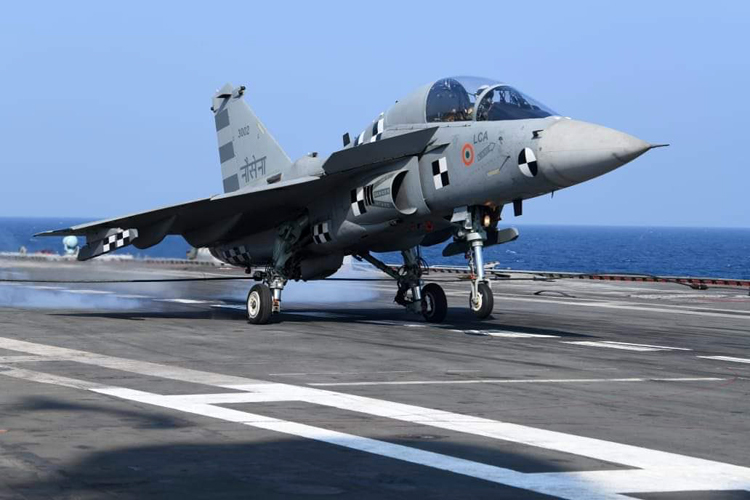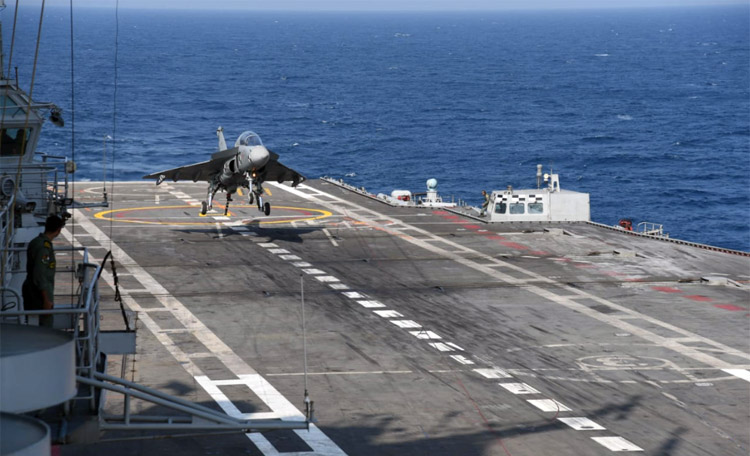INDIAN ARMED FORCES CHIEFS ON
OUR RELENTLESS AND FOCUSED PUBLISHING EFFORTS

SP Guide Publications puts forth a well compiled articulation of issues, pursuits and accomplishments of the Indian Army, over the years

I am confident that SP Guide Publications would continue to inform, inspire and influence.

My compliments to SP Guide Publications for informative and credible reportage on contemporary aerospace issues over the past six decades.
Indigenous Fighter Jet for Navy
 |
The Author is Former Director General of Information Systems and A Special Forces Veteran, Indian Army |

News reports of June 4 have confirmed that the Aeronautical Development Agency (ADA) under the Department of Defence Research and Development (DR&D) of the Ministry of Defence (MoD) has given the go ahead for the development of a twin engine Made-in-India fighter jet for the Indian Navy. The issue was discussed at the Annual General Body meeting of the ADA on May 22, chaired by Defence Minister Rajnath Singh and attended by the Navy and Air Force Chiefs. The successful arrested landing and takeoff the prototype of the naval version of Tejas on the deck of INS ‘Vikramaditya’ in January 2020 led to this decision.
Following the ADA Annual General Body meet on May 22, the Operational Requirements (ORs) for the new fighter were issued by the Integrated Headquarters of MoD (Navy). The development phase is expected to cost between 7,000 and 8,000 crore. The prototype of the new fighter-jet, designed to operate from the decks INS Vikramaditya and soon to be inducted INS Vikrant is required to fly within six years (2026) with induction of the fighter within a decade. The MoD had sanctioned 8000 crore in December 2009 to begin production of the fighter for the Indian Air Force and Indian Navy. Navy has a requirement for 50 Tejas aircraft and the first prototype, NP-1 was rolled out in July 2010. The Naval LCA made its first flight, almost two years after being rolled out, on 27 April 2012. In December 2014 the LCA Navy successfully conducted ski-jump trials at the Shore Based Test Facility (SBTF), INS Hansa. The naval variant has hands-free take-off, which reduces the pilot workload, as the ramp launches the aircraft on an upward flight path. The two-seater naval variant of Tejas successfully completed its first arrested landing on September 13, 2019 at the SBTF in Goa. Following the first arrested landing on January 11, 2020 on INS Vikramaditya, the Naval LCA Tejas performed its first ski-jump assisted take-off from the aircraft-carrier on January 12. While landing, the arrester hooks allowed the fighter to decelerate from approximately 244 km/h (the landing speed) to a standstill in approximately two seconds in a distance under 90 meters, within the length of the deck of INS Vikramaditya.

Those involved in the design and development of the new Indian fighter, an advanced variant of the single-engine Tejas-N, say that they have benchmarked the performance characteristics of the jet to Boeing's F/A-18 E/F Super Hornet, in service with the US Navy and the Marine Rafale, deployed on the French Navy aircraft carrier Charles de Gaulle. They say the new jet may imbibe technologies being developed for the IAF's Advanced Medium Combat Aircraft (AMCA) but will not be a stealth fighter in the same class. In December 2016, the Navy had found that the naval variant was overweight, which left them no alternatives to look elsewhere. Eventually, a request for information (RFI) was issued for 57 naval multirole fighters. However, the Navy also agreed to test the naval version of LCA Tejas when the next version was made available - NP-2 (Naval Prototype 2). NP-2 conducted its first taxi-in engagement on a naval platform at Goa to prove its hook-arrester system. Thereafter, the Defence Minister allowed the Navy to restart tests with NP-2. The first mid-air refueling of the Naval Tejas took place in September 2018. The experience gained in operating the Naval Prototype will help in providing input to the development of Twin Engine Deck Based Fighter (TEDBF) aircraft. The TEDBF will be powered by two General Electric F414 engines. The General Electric F414 is an American afterburning turbofan engine in the 22,000-pound thrust class produced by GE Aviation. It originated from GE's widely used F404 turbofan, enlarged and improved for use in the Boeing F/A-18E/F Super Hornet. The TEDBF will carry higher and heavier payloads and range. Labelled as the Omni-Role Combat Aircraft it is to sport two engines, elongated fuselage and an expanded wing-span, diverter-less supersonic inlets, conformal fuel tanks etc. Three variations of the design of the new fighter are being studied presently and Computational Fluid Dynamics (CFD) tests and wind tunnel modeling will ensure the optimum shape of the fighter to match its projected operational capabilities. It's still unclear whether the new fighter will be a tail-less delta platform, similar to the IAF's LCA Tejas fighter or, for that matter, feature canards, a small forewing placed ahead of the main wing of the aircraft to aid maneuverability.
The new fighter, once inducted, is meant to supplement and ultimately replace the Indian Navy's fleet of MiG-29K fighters presently in service on board the INS Vikramaditya. A high-performance jet, the MiG-29K has been plagued with serviceability issues in Indian Navy service. The new indigenous fighter will reportedly be armed with at least six air to air missiles with an operational endurance of approximately two hours. Making the naval version twin-engine prototype ready for trails within six years is a challenge which hopefully HAL will meet. Finally, India must develop its own aero-engines if it is to become a super power.





